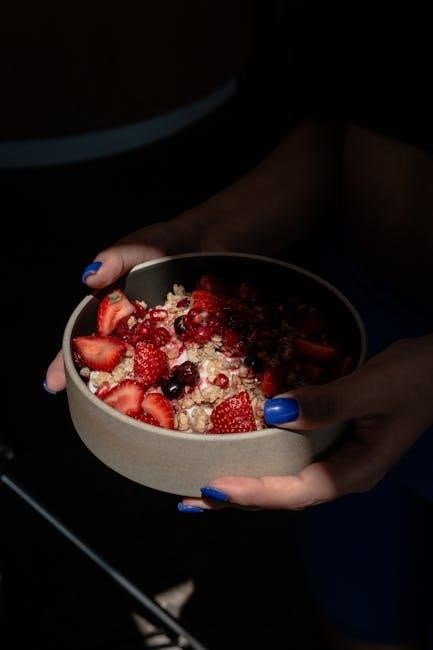Overactive bladder (OAB) is a common condition causing urgent and frequent urination. Diet plays a significant role in managing symptoms, with certain foods and beverages acting as triggers or relievers.
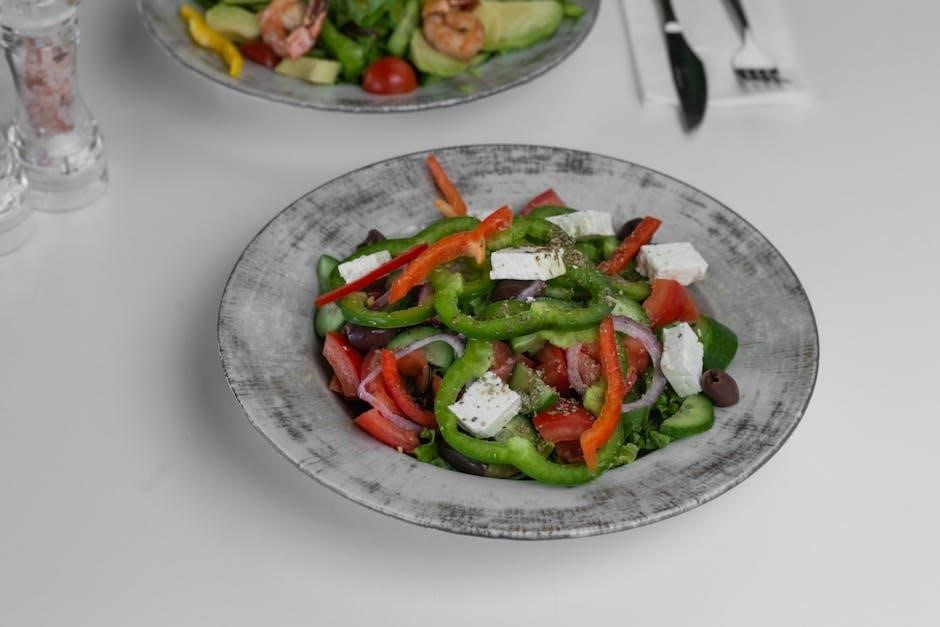
1.1 Understanding Overactive Bladder (OAB)
Overactive bladder (OAB) is a common condition characterized by involuntary bladder muscle contractions, leading to symptoms like urgency, frequency, and nocturia. It disrupts daily life, causing anxiety and discomfort. OAB is not caused by an infection but can result from neurological issues, bladder sensitivity, or muscle overactivity. While it is not curable, symptoms can be managed through lifestyle changes, medications, and dietary adjustments. Understanding the condition is the first step toward effective management and improving quality of life for those affected.
1.2 The Impact of Diet on Bladder Health
Diet significantly influences bladder health, as certain foods and drinks can trigger or alleviate symptoms of overactive bladder. Foods high in acidity, caffeine, and spices often irritate the bladder, worsening urgency and frequency. A balanced diet rich in fiber, lean proteins, and anti-inflammatory vegetables can help reduce inflammation and improve bladder function. Proper hydration is also crucial, as water helps maintain bladder health without irritating it. Understanding how specific nutrients affect the bladder can empower individuals to make informed dietary choices for better symptom management and overall well-being.
Common Symptoms and Causes of Overactive Bladder
Common symptoms include urgent urination, frequent trips to the bathroom, and nocturia. Causes involve bladder muscle overactivity, nerve signal miscommunication, and lifestyle factors like diet and stress.
2.1 Symptoms of OAB
Overactive bladder symptoms include a sudden, urgent need to urinate, frequent trips to the bathroom, and nocturia (waking up multiple times at night to urinate). Some individuals may experience urge incontinence, where leakage occurs before reaching the bathroom. These symptoms can significantly disrupt daily activities and sleep quality, often causing anxiety and discomfort. Understanding these signs is crucial for proper diagnosis and management.
2.2 Potential Causes and Triggers
Overactive bladder can result from neurological issues, bladder muscle overactivity, or hormonal changes. Dietary triggers like caffeine, alcohol, and spicy or acidic foods may worsen symptoms; Fluid intake and dehydration also play roles, as concentrated urine can irritate the bladder. Identifying and managing these factors is key to reducing symptoms and improving quality of life for those with OAB.
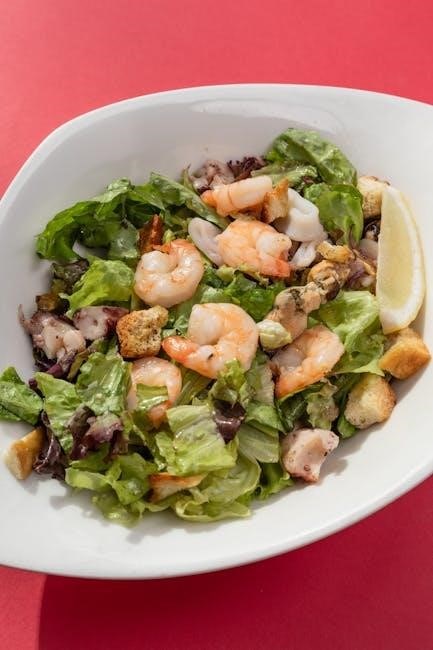
Foods to Incorporate for Bladder Health
Incorporating lean proteins, fiber-rich foods, non-citrus fruits, whole grains, and anti-inflammatory vegetables can help alleviate overactive bladder symptoms by reducing irritation and promoting overall urinary health.

3.1 Lean Proteins
Lean proteins like fish, chicken breast, turkey, low-fat beef, and pork are excellent choices for bladder health. They provide essential nutrients without irritating the bladder. Incorporating these proteins can help reduce inflammation and support overall urinary function. Opting for low-fat options and preparing them without spicy seasonings can further enhance their benefits for managing OAB symptoms.
3;2 Fiber-Rich Foods
Fiber-rich foods, such as beans, lentils, and whole grains, are beneficial for bladder health. They promote regular bowel movements, reducing pelvic pressure on the bladder. This can alleviate OAB symptoms like urgency and frequency. Additionally, fiber helps maintain a healthy digestive system, preventing constipation, which can exacerbate bladder issues. Incorporating these foods into your diet supports overall urinary function and may reduce inflammation, creating a more balanced and supportive environment for bladder health.
3.3 Non-Citrus, Low-Acid Fruits
Non-citrus, low-acid fruits like pears, blueberries, and bananas are ideal for bladder health. They provide essential nutrients and antioxidants without irritating the bladder lining. Citrus fruits, in contrast, contain ascorbic acid, which can worsen OAB symptoms by increasing bladder contractions. Opting for low-acid options helps maintain a balanced diet while minimizing discomfort. These fruits also contribute to overall hydration needs, supporting urinary function without triggering urgency or frequency.
3.4 Whole Grains
Whole grains, such as brown rice, quinoa, and oats, are rich in fiber and antioxidants, which support bladder health. Fiber aids digestion, preventing constipation that can worsen OAB symptoms. Antioxidants reduce inflammation, potentially calming bladder irritation. Incorporating whole grains into meals helps maintain a balanced diet and supports overall urinary health. They are non-irritating and provide sustained energy, making them a beneficial addition for managing OAB symptoms effectively.
3.5 Anti-Inflammatory Vegetables
Anti-inflammatory vegetables like broccoli, cucumbers, and leafy greens are rich in antioxidants and fiber, which can help reduce bladder inflammation. These vegetables support digestive health, preventing constipation that may worsen OAB symptoms. Incorporating them into meals promotes a balanced diet and helps maintain urinary health. Their mild, non-irritating properties make them ideal for managing OAB, while their nutritional benefits contribute to overall well-being and symptom relief.

Foods and Drinks to Avoid
Caffeinated beverages, spicy foods, citrus juices, and dairy products can irritate the bladder, worsening OAB symptoms. Avoiding these triggers may help reduce urgency and frequency.
4.1 Caffeine and Carbonated Beverages
Caffeine, found in coffee, tea, and some sodas, can worsen overactive bladder symptoms by increasing urine production and irritating the bladder. Carbonated beverages, such as soda and sparkling water, can also trigger discomfort due to their carbonation, which may irritate the bladder lining. Reducing or eliminating these drinks can help alleviate urgency and frequency, improving overall bladder control. Opting for water or herbal teas is often recommended as a bladder-friendly alternative.
4.2 Spicy Foods
Spicy foods can exacerbate overactive bladder symptoms by irritating the bladder lining and increasing sensitivity. While research is limited, many individuals report that spicy foods trigger urgent urination. Consider reducing intake or substituting spices with herbs for flavor. If symptoms improve, it may be beneficial to avoid spicy foods, but maintaining nutrient-rich options is essential. Monitoring personal triggers through a food diary can help customize a diet plan effectively.
4.3 Citrus Fruits and Juices
Citrus fruits and juices, such as oranges and grapefruits, contain ascorbic acid, which can increase bladder contractions and worsen OAB symptoms. Reducing or avoiding these may alleviate urges and discomfort. Opting for low-acid fruits like bananas, apples, or pears can provide essential nutrients without triggering symptoms. Balancing fruit intake while monitoring fluid contribution from such sources is crucial for managing bladder health effectively.
4.4 Dairy Products
Dairy products can exacerbate overactive bladder symptoms in some individuals. Milk, cheese, and yogurt contain tyrosine and phenylalanine, which may increase bladder activity. Additionally, lactose in dairy can irritate the bladder lining, leading to urgency and frequency. Opting for low-lactose or non-dairy alternatives may help reduce symptoms. Monitoring personal tolerance to dairy is essential, as reactions can vary widely among individuals with OAB.
The Mediterranean Diet and OAB
The Mediterranean Diet, rich in fruits, vegetables, whole grains, and healthy fats, has been linked to reduced OAB symptoms due to its anti-inflammatory effects and bladder-friendly properties.
5.1 Benefits of the Mediterranean Diet
The Mediterranean Diet offers significant benefits for managing OAB by focusing on whole, nutrient-rich foods that reduce inflammation and bladder irritation. It emphasizes fruits, vegetables, whole grains, lean proteins, and healthy fats, which are naturally anti-inflammatory and bladder-friendly. This dietary approach helps improve bladder function, reduces symptom severity, and supports overall urinary health. By avoiding processed foods and focusing on antioxidant-rich options like berries, leafy greens, and whole grains, individuals can better manage OAB symptoms and enhance their quality of life.
5.2 Foods Emphasized in the Mediterranean Diet
The Mediterranean Diet highlights whole, unprocessed foods such as fruits, vegetables, whole grains, lean proteins, and healthy fats. Leafy greens, berries, and non-citrus fruits like pears and bananas are recommended for their anti-inflammatory properties. Whole grains, legumes, and nuts provide fiber, which supports digestive health and reduces bladder pressure. Lean proteins like fish and poultry, along with healthy fats from olive oil and avocados, further enhance the diet’s bladder-friendly profile. This approach minimizes bladder irritants and promotes overall well-being;
Hydration and Fluid Management
Proper hydration is essential for managing overactive bladder, but excessive fluid intake can worsen symptoms. Balancing water and non-irritating beverages helps maintain bladder health without triggering urgency.
6.1 The Importance of Proper Hydration
Proper hydration is essential for overall health, but it plays a unique role in managing overactive bladder (OAB). Water helps maintain urine consistency and prevents concentrated urine, which can irritate the bladder. However, excessive fluid intake can exacerbate symptoms like urgency and frequency. Balancing hydration without overdoing it is key. Avoid caffeinated and carbonated drinks, as they can act as bladder irritants. Consulting a healthcare provider to tailor fluid intake to individual needs is recommended to optimize bladder health and reduce OAB symptoms effectively.
6.2 Balancing Fluid Intake
Balancing fluid intake is crucial for managing overactive bladder (OAB). While staying hydrated is important, excessive fluids can worsen symptoms like urgency and frequency. It’s essential to avoid overhydration and spread fluid consumption evenly throughout the day. Caffeinated and carbonated beverages should be limited, as they can irritate the bladder. Monitoring how different fluids affect symptoms and adjusting intake accordingly can help find a balance that supports bladder health without triggering discomfort. This tailored approach ensures optimal hydration while minimizing OAB-related issues.

Identifying Personal Food Triggers
Identifying personal food triggers is key to managing overactive bladder. A food diary can help track symptoms and pinpoint irritants like citrus, caffeine, or spicy foods. This process allows customization of a diet plan to minimize bladder irritation and alleviate symptoms effectively.
7.1 Keeping a Food Diary
A food diary is a powerful tool for identifying triggers of overactive bladder symptoms. By documenting daily food intake and corresponding symptoms, individuals can pinpoint specific foods or beverages that exacerbate urgency or frequency. This personalized approach helps create a tailored diet plan, reducing bladder irritation and improving quality of life. Consistent tracking over weeks reveals patterns, enabling informed decisions to eliminate or avoid problematic items while maintaining a balanced and nutritious diet.
7.2 Customizing Your Diet Plan
Using insights from your food diary, create a personalized diet plan tailored to your needs. Identify and avoid specific foods that trigger symptoms, such as spicy or acidic items. Incorporate bladder-friendly options like lean proteins, whole grains, and non-citrus fruits. Gradually adjust your diet to minimize irritants while ensuring balanced nutrition. Consider consulting a healthcare professional or dietician to refine your plan further. Regularly monitor progress and make adjustments as needed to optimize bladder health and reduce symptoms effectively.
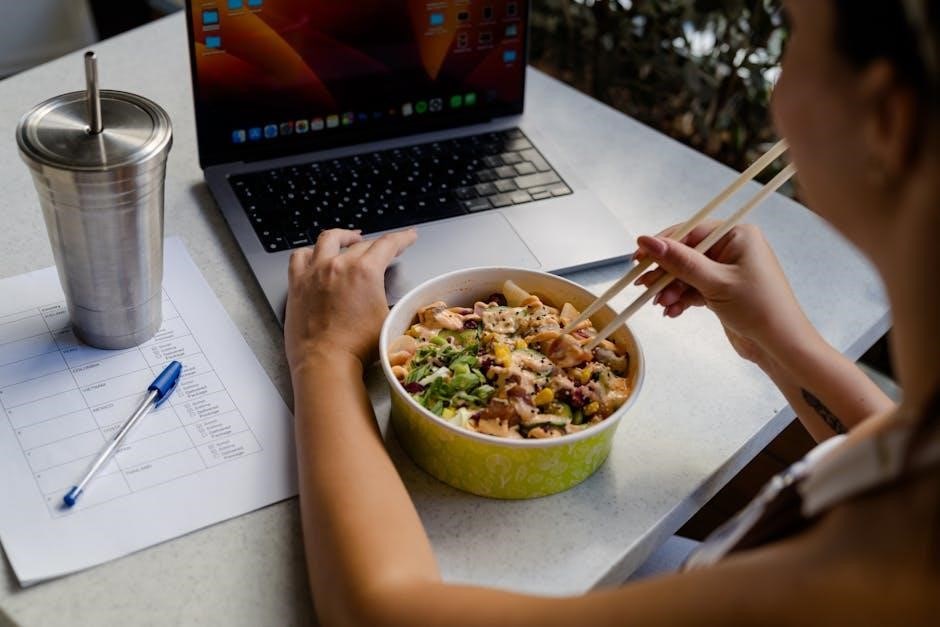
Lifestyle Changes Beyond Diet
Beyond diet, lifestyle changes like pelvic floor exercises, bladder retraining, and stress management can significantly improve overactive bladder symptoms, helping to strengthen muscles and restore bladder control.
8.1 Pelvic Floor Exercises
Pelvic floor exercises, such as Kegel exercises, are essential for managing overactive bladder. These exercises strengthen the muscles that control urination, improving bladder control and reducing symptoms. To perform Kegels, tighten the pelvic muscles as if stopping urine flow, hold for 5-10 seconds, then release. Repeat 10-15 times, 3-4 times daily. Regular practice can enhance muscle strength and reduce urgency and leakage, providing long-term relief from OAB symptoms.
8.2 Bladder Retraining Techniques
Bladder retraining is a behavioral technique to improve bladder control and reduce OAB symptoms. It involves gradually increasing the time between bathroom visits to train the bladder to hold more urine. Start with short intervals, like 30 minutes, and slowly extend the time by 15-30 minutes each week. This method helps strengthen bladder muscles and reduce urgency. Consistency and patience are key, as it may take weeks to notice improvements. Bladder retraining is often combined with pelvic floor exercises for better results.
8.3 Managing Stress
Stress can worsen overactive bladder symptoms by tightening pelvic muscles and increasing urgency. Techniques like yoga, deep breathing, and mindfulness can help relax the body and reduce bladder sensitivity. Regular relaxation practices improve overall well-being and bladder control. Identifying stress triggers and adopting calming strategies can alleviate symptoms. Managing stress complements dietary changes and other therapies, offering a holistic approach to OAB management.
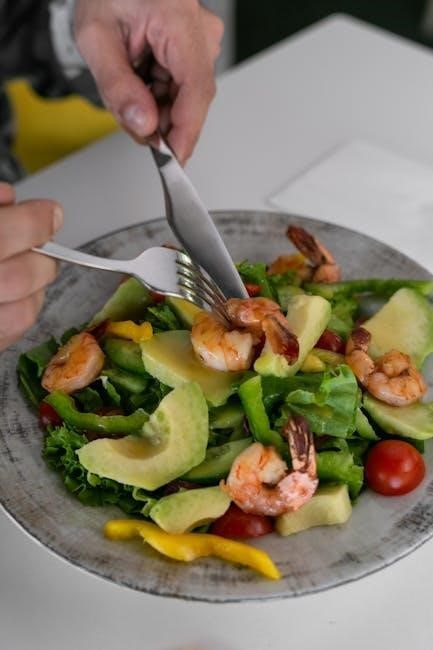
The Role of Supplements and Nutrients
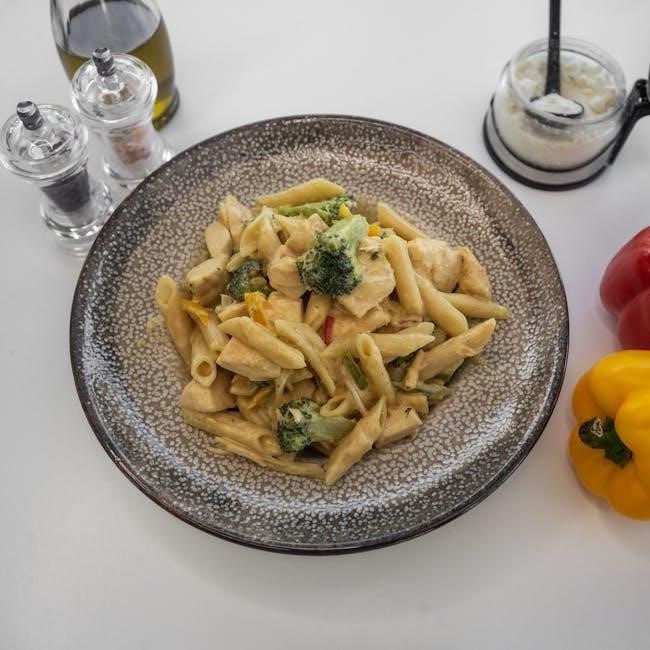
Supplements like magnesium and vitamin C can support bladder health by relaxing muscles and reducing irritation, potentially alleviating OAB symptoms when combined with dietary adjustments.
9.1 Magnesium and Vitamin C
Magnesium helps relax the bladder muscles, reducing spasms and urgency. Vitamin C supports overall bladder health and may decrease inflammation. Incorporating magnesium-rich foods like spinach and almonds, and vitamin C sources such as non-citrus fruits, can complement dietary strategies for managing OAB symptoms effectively.
9.2 Herbal Remedies
Certain herbal remedies, such as cranberry extract and soy isoflavones, may help alleviate overactive bladder symptoms. Cranberry can prevent bacterial adhesion in the urinary tract, while soy isoflavones support bladder muscle relaxation. However, effectiveness varies, and consulting a healthcare provider before starting herbal supplements is essential to ensure safety and avoid interactions with medications.
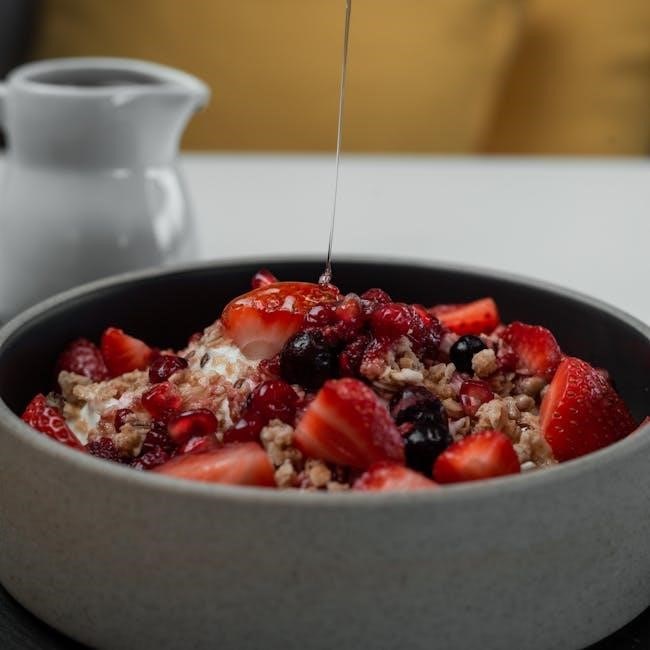
Recent Research on Diet and OAB
Recent studies highlight the benefits of a high-fiber, antioxidant-rich diet in reducing OAB symptoms, while also emphasizing the role of weight management in improving bladder health.
10.1 Studies on Fiber and Antioxidants
Research indicates that diets rich in fiber and antioxidants can significantly alleviate OAB symptoms. Fiber helps regulate bowel movements, reducing pelvic pressure on the bladder, while antioxidants calm inflammation. Studies suggest that whole grains, beans, and vegetables high in these nutrients may reduce bladder irritation and frequency; The Mediterranean diet, emphasizing such foods, has shown promise in lowering OAB risk. These findings highlight the potential of dietary adjustments to complement traditional treatments and improve quality of life for those with OAB.
10.2 The Role of Weight Management
Weight management is crucial in managing overactive bladder symptoms. Excess weight increases intra-abdominal pressure, which can overburden the bladder and pelvic muscles. Studies have shown that even moderate weight loss can significantly reduce urinary frequency and urgency. A healthy diet combined with regular physical activity helps maintain a balanced weight, thereby alleviating pressure on the bladder. This approach not only improves OAB symptoms but also contributes to overall health and well-being, making it a key component of a comprehensive management plan.
Diet and lifestyle changes significantly impact overactive bladder management. By avoiding triggers, staying hydrated, and adopting a balanced diet, individuals can effectively alleviate symptoms and improve quality of life.
11.1 The Importance of a Comprehensive Approach
Managing overactive bladder requires a holistic strategy that combines dietary adjustments, lifestyle changes, and medical treatments. A comprehensive approach ensures that all aspects of bladder health are addressed, from reducing irritants in the diet to incorporating exercises like pelvic floor strengthening. This multi-faceted strategy not only alleviates symptoms but also enhances overall well-being. By adopting a tailored plan that includes healthy eating, stress management, and regular physical activity, individuals can better control OAB and improve their quality of life effectively.
11.2 Final Tips for Managing OAB Through Diet
Diet plays a crucial role in managing overactive bladder symptoms. Focus on incorporating lean proteins, fiber-rich foods, and non-acidic fruits like bananas and pears. Avoid bladder irritants such as caffeine, spicy foods, and citrus juices. Stay hydrated but balance fluid intake to prevent overhydration. Consider adopting the Mediterranean diet for its anti-inflammatory benefits. Track food triggers using a diary and adjust your diet accordingly. Maintaining a healthy weight and avoiding processed foods can also help alleviate symptoms. Consult a healthcare provider for a personalized plan tailored to your needs.
